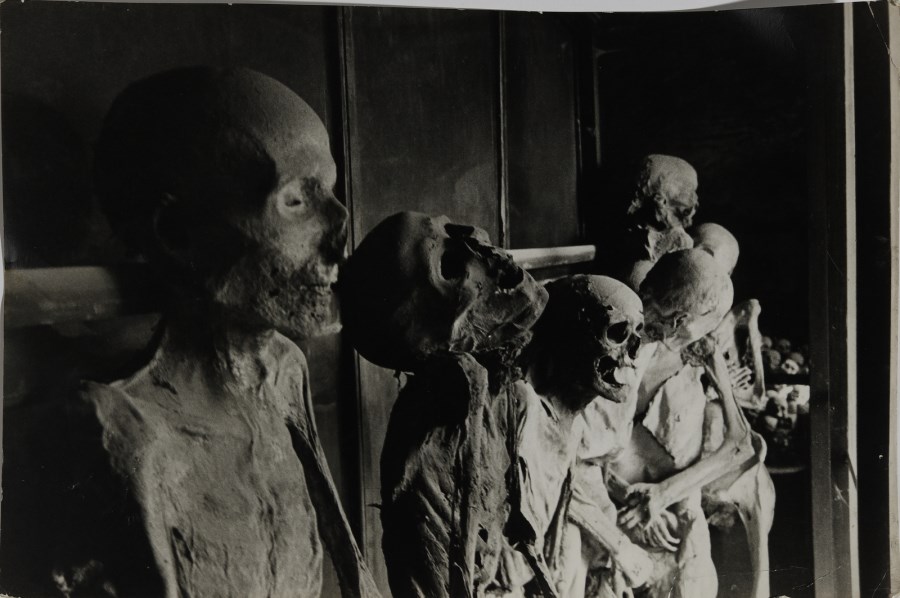
Auction 344 Modern & Contemporary Art (Online)
Lot 58
Franco Pinna
Mummie.
At the back credit of the artist. Defects. Provenance: Casa Bernardino Zapponi, one of Federico Fellini's historical screenwriters. Franco Pinna is the photographer who has followed the Maestro in many films and also made the history of Fellini's imagination. The photo presented, however, comes from the period of his collaboration with the great anthropologist Ernesto De Martino, the father of modern anthropology, with whom he worked for a long time in the mid-1950s, touring magical and mysterious Italy such as Salento, La Lucania, documenting and recounting phenomena such as tarantism for example.
The photos in this series are a tribute to the Memento Mori set in the crypt of the Abbey of San Pietro In Valle, inside the River Nera Park, one of the most evocative places in the whole of Umbria. A crypt dating back to the 15th century.
From the sixteenth century. onwards all the deceased of the Borgo di Precetto were buried here (the practice of burial was presumably up to the Order of the Capuchin Friars Minor) until the issuance of the Napoleonic Edict of Saint Cloud "Décret Impérial sur les Sépultures" extended to Italy in 1806, banned any burial within the city walls and extra-urban cemeteries were established (the last burial in the crypt took place on May 18, 1871). In addition to banning their burial, the exhumation of the bodies inside the crypt was ordered and only at that moment was it possible to ascertain the perfect mummification of some of them whose bodies, yellowish in color, at a first autoptic inspection revealed that their mummification was completely spontaneous and which was mainly due to a total drying of the soft parts. In addition to preserving the skin, some of them still had intact nails, teeth, ears, lips, genitals, beards and hair. Many were the scholars who at the end of the nineteenth century. they went to Ferentillo to study this phenomenon, including two physicists from the Accademia dei Lincei, Dr. Carlo Maggiorani (1800 - 1885) and Dr. Aliprando Moriggia (1830 - 1906), supported by the chemist Vincenzo Latini (1805 - 1862) ). The latter carried out chemical analyzes of the soil which highlighted how this was mainly composed of calcium salts, limestone and clay. According to these studies, the hygroscopic nature (which attracts water) of the soil would have favored the dehydration of buried corpses, while the cool and dry environment, ventilated through continuously open windows, would have enhanced the process. Probably also influenced by the observations on the mummies of Venzone, they thought that - in addition to the physical factors highlighted - the growth of fungi could have played a role in drying the bodies. It could also be assumed that the bodies buried in a soil rich in calcium oxide were preserved thanks to the inactivation of enzymes resulting from the alteration of the degree of acidity. The bodies were in fact buried in direct contact with the ground (only some were found in coffins), arranged along the perimeter of the walls and left to decompose in order to be able to burial the remains in the ossuary of the Crypt. To date there are 24 human mummies (three are exhibited at the Anatomical Museum of the University of Perugia) which include men, women and children as well as 10 preserved heads, more than 270 skulls, a sealed coffin and two birds mummified as a result of experiments made in the last century.
During the last cleaning and maintenance interventions of the Crypt, graves were found in the room before the Crypt, perhaps intended for the non-baptized.
Starting price: € 10,00
Estimate: € 250,00 - 350,00
Do you own a work by and want to sell it?
The department of ARTE MODERNA E CONTEMPORANEA select works of art by the artist to be included in the next auction.
Request a free valuation
Our specialists are always available to provide free and confidential valuations and appraisals.
Choose one of the following contact methods:
- Send us a request online
- Take a picture and send it via WhatsApp to 339.9908224
- Call the phone number 030 2056796
- Write to us at valutaopera@capitoliumart.it
- Book an appointment









